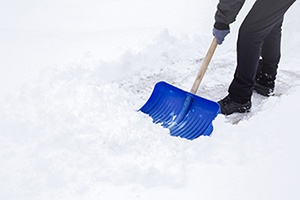 Shoveling snow, using snow blowers, and removing snow from roofs bring hazards for your workers. Educate your employees on both the dangers and proper snow removal techniques this winter to prevent injuries.
Shoveling snow, using snow blowers, and removing snow from roofs bring hazards for your workers. Educate your employees on both the dangers and proper snow removal techniques this winter to prevent injuries.
Shoveling Snow
Cold weather can be quite tasking on the body. When individuals are shoveling snow, they can be at risk for exhaustion, dehydration, back injuries, and even heart attacks. Encourage workers to take frequent breaks in warm areas and to push the snow rather than lifting it. Proper footwear is critical to avoiding slips, trips, and falls on icy and wet surfaces, as well as appropriate clothing to protect from the frigid temperatures.
Using Powered Equipment Like Snow Blowers
Ensure equipment is properly grounded to prevent electric shock or electrocutions. Educate employees on safe use of the snow blower – consider these safety tips from Consumer Reports. To keep workers safe, don’t forget to train employees on proper maintenance and cleaning procedures. Take time to provide refresher training before winter weather strikes each season so your employees remember how to safely operate, maintain, and clean the equipment.
Clearing Snow From Roofs & Working At Heights
When clearing snow from heights extra caution is critical. There are extra dangers when removing snow from a roof, so consider the following tips from OSHA to protect your workers from these hazards:
- Before snow begins to accumulate, think about what will be needed to safely remove it from roofs and elevated surfaces.
- Use snow removal methods that do not involve workers going on roofs, when and where possible. This could include using ladders to apply de-icing materials and utilizing snow rakes or drag lines from the ground.
- Evaluate loads exerted on roof or structure (e.g., total weight of snow, workers and equipment used), compared to the load limit of the roofs.
- Require that workers use fall protection equipment.
- Ensure that workers use ladders and aerial lifts safely.
- Protect people on the ground during the snow removal process by marking safe work zone areas where the snow is to be removed, wearing proper eye and head protection, and removing small amounts of snow at a time.
Protect your workers this winter by informing them about the hazards associated with snow removal and educating them on how to get the job done safely!



